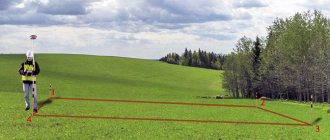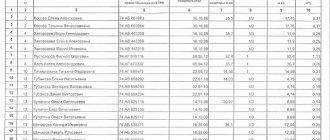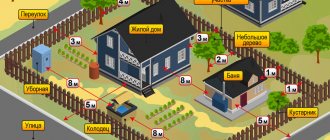The land plot on which the apartment building is located, as well as the objects located on this site intended for the maintenance, operation and improvement of the apartment building (hereinafter referred to as the adjacent territory), belong to the common property of the owners of the premises in the apartment building. Accordingly, maintaining the local area in proper condition is part of the maintenance and repair of the common property of the apartment building (Part 1 of Article 39 of the Housing Code of the Russian Federation
;
pp. “f”, “g” clause 2 of the Rules for the maintenance of common property in an apartment building, approved. Decree of the Government of the Russian Federation dated August 13, 2006 No. 491
(hereinafter referred to as
Rules No. 491
)).
The procedure for maintaining and improving the local area
The maintenance of the local area includes, in particular (clauses “d”, “d”, “d (2)”, “g”, “h” clause 11 of Rules No. 491
;
pp. 24 - 26 (1) Minimum list of services and works, approved. Decree of the Government of the Russian Federation dated April 3, 2013 No. 290
;
clause 2 of the Decree of the Government of the Russian Federation dated February 27, 2017 No. 232
):
• cleaning of a land plot that is part of the common property;
• collection and removal of liquid household waste, as well as maintenance of structures and equipment used for their accumulation in apartment buildings that are not connected to a centralized drainage system;
• work on the organization and maintenance of places (sites) for the accumulation of solid municipal waste, including maintenance and cleaning of garbage chutes, garbage collection chambers and container sites (subject to an appropriate agreement between the government of the constituent entity of the Russian Federation and the regional operator). The specified work does not include cleaning of loading areas for such waste;
• maintenance and care of landscaping and landscaping elements located on a land plot that is part of the common property;
• current and major repairs, preparation for seasonal operation of landscaping elements located on the land plot.
Cleaning of the territory should be carried out daily, including in the warm season - watering the territory, in winter - de-icing measures (removal, sprinkling with sand, de-icing reagents, etc.).
When landscaping the local area, it is necessary to take into account that the distance from the walls of residential buildings to the axis of tree trunks with a crown with a diameter of up to 5 m should be at least 5 m. For larger trees, the distance should be more than 5 m, for shrubs - 1.5 m. Height shrubs should not exceed the lower edge of the window opening of the first floor premises (clauses 2.4, 2.11 SanPiN 2.1.2.2645-10, approved by Resolution of the Chief State Sanitary Doctor of the Russian Federation dated June 10, 2010 No. 64
).
The improvement of the local area can include, in particular, the restoration of destroyed sections of sidewalks, paths, pavement of fences and equipment for sports, utility and recreation areas, platforms and sheds for waste containers, asphalting, installation of fences, carried out as part of current or major repairs. equipment for children's and utility playgrounds (clause 17 of Appendix No. 7, clause 3 of Appendix No. 8 to the Rules, approved by Resolution of the State Construction Committee of Russia dated September 27, 2003 No. 170
).
The adjacent territory must be maintained in accordance with the requirements of legislation (including on the sanitary and epidemiological welfare of the population, technical regulation and protection of consumer rights) in a condition that ensures, in particular (clause 10 of Rules No. 491
):
• compliance with the reliability and safety characteristics of MKD;
• safety for the life and health of citizens, safety of property;
• accessibility of use of the land plot on which the apartment building is located, including for people with disabilities and other groups of the population with limited mobility.
Administrative liability is provided for improper maintenance of the local area (Article 7.22, 8.1, 8.2, Part 2, Article 14.1.3, Article 14.4 of the Code of Administrative Offenses of the Russian Federation
).
Sanitary condition: features for multi-apartment residential buildings
In the matter of maintaining the local area in proper form, one cannot help but pay attention to the term “sanitary maintenance”. The concept of sanitary maintenance refers to a single set of procedures and works that include actions to repair the housing stock.
The maintenance of a specific local area is a set of works that is basic and helps to maintain the condition of the territory in accordance with the standards and requirements established by sanitary-epidemiological and environmental services and requirements.
Closely related to this term is the term improvement. It refers to a set of works that are aimed at improving the aesthetic characteristics of the territory. To give an example, sanitary maintenance and improvement include placing garbage cans away from playgrounds and recreation areas.
The range of sanitation services includes cleaning activities that are used by all homeowners in an apartment building.
Employees of the management organization or the homeowners themselves must disinfect the premises and systematically remove garbage and snow. To maintain your home in a well-maintained state, you need to pay attention to mowing the lawns, planting flowers in the flower beds, and caring for the plants.
Landscaping also includes the manufacture and installation of metal fences, painting of facades, gates, grilles, installation of benches and their maintenance.
This is important to know: How to register ownerless land as property
Arrangement of children's playgrounds.
It is difficult to imagine a cozy courtyard of an apartment building without a children's playground. The presence of children's playgrounds is a fact that the building has an established infrastructure, which means that an apartment in this building may cost slightly more than in others. However, playgrounds must also meet certain requirements:
First of all, they must be located at a certain distance from roadways, places where garbage cans are located, as well as from technical premises.- Playground structures should be as safe as possible.
- The structure on the playground must be strong and well secured.
- Deformed structures must either be corrected or removed to avoid traumatic situations.
- If possible, playgrounds should be fenced with an appropriate fence or hedge to make it difficult for a child to enter the roadway or courtyard area.
Also, the employees of the management company have the responsibility to correct various deformations and breakdowns. The playground should be designed for children of different age categories.
Asphalting
Asphalting the area in the yard is an issue decided by management companies and residents . Of course, everyone inhabiting the house wants to move on a flat and smooth surface, and not climb over clods of dirt.
In order to asphalt the local area, a special fund must be created, where residents must contribute money for the work of laying asphalt. There are certain standards that must be taken into account when laying asphalt paths. It is not recommended to use fine-grained asphalt, as it is most prone to pitting. Also, the layer of asphalt coating must be at least 15 cm.
Adjacent territory: rights and responsibilities of the owner
As follows from the provisions of Part 1 of Art. 158 of the Housing Code of the Russian Federation, the owner of premises in an apartment building is obliged to participate in the costs of maintaining common property in proportion to his share in the right of common ownership. The specified share is proportional to the size of the total area of the premises owned by the person by right of ownership (Article 15 of the Federal Law “On the entry into force of the Housing Code of the Russian Federation”). Thus, the larger the area of the apartment, the more its owner will have to pay for the maintenance of the local area and other common property.
The management organization, on a reimbursable basis, provides services for the maintenance of the common property of apartment buildings and is responsible in case of provision of services of inadequate quality when choosing a method of managing an apartment building by concluding an agreement with the management organization.
We recommend reading: From what year is the insurance period for a pension considered?
Keeping the area where the buildings are located in order and cleanliness ensures the necessary operational and sanitary-hygienic condition of the premises and extends the service life of the buildings. Due to improper maintenance of the territory, the most difficult to eliminate defects occur in the walls, floors of the first floors and basements (for example, wet walls and dampness in the basement parts, dampness and flooding of basements with water, the formation of cracks in foundations and walls, dampness of floors in underground areas, etc. .). Therefore, proper maintenance of the territory is the primary responsibility of the building foreman (technician-caretaker).
Proper maintenance of the territory includes: maintaining the drainage system for rain and melt, surface and ground water in constant working order;
- timely cleaning of latrine cesspools, removal of garbage, waste and slops; disinfection of yard restrooms and places where garbage and slops are stored;
- maintaining fences and fences;
- maintenance of roads, pedestrian paths and blind areas and their timely repair;
- timely clearing of snow from the roofs of buildings and removing it from the territory;
- maintaining external water supply, sewerage, heating and drainage networks in order; timely sawing and preparation of water standpipes, taps, hydrants, fire reservoirs and wells for operation in winter conditions;
- maintenance of external electrical lighting, alarm, communication networks, as well as lightning rod systems;
- care and maintenance of trees, lawns, hedges, including timely watering, digging, pruning, etc.
According to the “Rules for the sanitary maintenance of territories of populated areas”, approved by the Main Sanitary and Epidemiological Directorate of the USSR Ministry of Health in 1982, responsibility for the sanitary condition and cleaning of the territory is assigned to the housing and communal services of local Councils and departments. In this regard, technicians-supervisors of buildings, heads of housing and communal departments and offices, and building managers must study the current resolutions of local Councils of People's Deputies on issues related to the maintenance of the territory of households, familiarize the staff of the building managements with them and establish control over their implementation. Supervisor technicians must ensure that the ballot boxes are installed at a distance of 50 m from each other along the front line of the central part of the streets of regional centers and 100 m on other streets and in courtyards.
Garbage containers should be installed in the courtyards of households for solid waste and separately for waste and food waste; premises have been arranged for cleaning equipment (crowbars, picks, shovels, scrapers, scoops, sliders, brooms, watering hoses, carts for garbage bins, etc.); allocated places or rooms for sand storage.
You should use portable metal garbage containers with a capacity of 50-100 liters, installed in a special room or under a canopy on a concrete or asphalt area, or containers with a capacity of 400-800 liters, transported on special vehicles (for houses with a population of 240-300 people and above). In areas with harsh climates, it is advisable to place containers in closed, heated rooms to avoid waste freezing and freezing to the walls of the containers. One portable waste bin requires an area of about 2 m2. The number and capacity of waste bins should be determined based on the accumulation of 1.3-1.7 liters of waste per person. in a day; The roofs of waste containers must always be tightly closed.
It is necessary to coordinate with the sanitary authorities the location of waste bins, if according to the conditions it is necessary to reduce the specified repentance, and with trusts (departments) for cleaning six or more waste bins in one place, as well as when using containers. If up to six waste bins are installed in one place, they must be moved to traffic routes at a distance of no more than 25 m.
If there are six or more waste bins in one place, and when using containers, vehicle access must be provided to the site. Arbitrary dispersal of waste bins is not permitted; The location of waste bins should be convenient for their use. It is not recommended to install more than 12 portable garbage containers in one place, and if there are more of them, it is advisable to use containers.
Areas for placing waste bins must be equipped with running water. In open areas, waste bins are washed only in warm weather over a specially constructed receptacle-well equipped with a grate and a lid.
Garbage containers in buildings must be separated from other premises by permanent water- and gas-tight barriers. Walls and ceilings should be covered with cement plaster, painted with oil paint in light colors. It is advisable to cover the walls with glazed tiles in light colors. To prevent the appearance of rodents, steel mesh is placed in wooden walls to a height of 0.3 m and the floors near the doors are covered with steel sheets.
The floors of the premises (concrete, asphalt or tiles) must be smooth and without depressions with a slope of 0.01 to the ladder. The premises must be equipped with ventilation and, if possible, they should have natural light. In summer, forced ventilation is provided; ventilation openings must be equipped with mesh with cells no larger than 1.5X1.5 mm to protect against flies. The dimensions of the premises are determined by the project. Cesspools must be installed in non-sewered households. The capacity of the cesspools of such pits is determined from the condition that the daily accumulation of slops per person. is -36 l. The walls and bottom of cesspools should not allow liquid to pass through.
When cleaning the territory, sidewalks and roadways are cleaned throughout the entire property area. If the property's plot overlooks driveways adjacent to boulevards and squares, or embankments, the roadway is cleared to its full width, including sidewalks along the boulevard, square and embankment; in front of metro stations located on the first floors of buildings, sidewalks and the roadway of the street are cleaned throughout the entire property area.
The areas of tram, trolleybus and bus stops located in front of the house are completely cleaned. The area around kiosks, tents, stalls at a distance of 5 m must be cleaned by the staff of these retail outlets.
Streets, sidewalks and courtyards are cleaned at hours established by local Councils of People's Deputies. On streets and squares with improved road surfaces, the main cleaning work is carried out by specialized organizations. On transit and main streets, the clearing and removal of fallen snow must be completed within the time frame established by the local Council of People's Deputies (before the start of heavy traffic).
When clearing snow on highways and transit streets with improved surfaces (asphalt, paving stones), where vehicular traffic predominates, the snow must be cleared using a scraper. When clearing other streets and internal passages, you can leave a layer of snow up to 15 cm thick to form a dense snow crust. Sidewalks with smooth surfaces should be scraped. The covers of water supply and sewer wells must be completely cleared of snow.
Snow is collected in heaps or shafts (no higher than 1 m), located parallel to the sidewalk, and they should not hinder street traffic, cover gutters and ditches, as well as the covers of water wells. Gaps of a certain width are left in the embankments against public transport stops, pedestrian paths, and entrances. On main streets where trolleybuses pass, the pile of collected snow should be placed at a distance of 30 cm from the sidewalk; the width of the base of the shaft must exceed 1.5 m. The snow cover on the streets must be even, the mounds and slopes that form over time must be immediately chipped off, the ice must be collected in heaps and taken to landfills. It is prohibited to dump snow and ice on boulevards, squares, gardens, marks and green areas of courtyards.
In the spring, grooves for water drainage should be dug and cleaned, snow cover should be removed from the roadways of streets and sidewalks, snow and chipped ice should be collected in heaps and taken to landfills, gutters should be cleared of snow and ice, and melt water should be systematically driven to gutters and receiving wells. .
In the summer, it is necessary to clean, wash and water the territories assigned to housing and communal services, as well as remove garbage within the time limits established by the Council of People's Deputies; sweep away puddles that form on the sidewalks after rain or watering from pavements and sidewalks to the receiving wells of the drainage network; clean (but do not open) drainage grates from debris and dirt that impede the normal flow of surface water.
In the fall, before the onset of frost, rainwater should be systematically driven to gutters and receiving wells, and general cleaning of courtyard areas should be carried out.
It is necessary to regularly wash and disinfect garbage containers in accordance with the instructions of sanitary authorities, and promptly clear them of debris. Construction waste must be stored separately and removed as it accumulates using the forces and means of the organization carrying out the repairs, but at least once every 10 days.
From houses that are not equipped with garbage chutes, residents take out household waste into containers installed in the local area adjacent to them at a distance of no closer than 20 and no further than 100 m from residential buildings. From houses that do not have a sewer system, residents remove liquid household waste into special containers installed in the local area at a distance of no closer than 20 and no further than 100 m.







